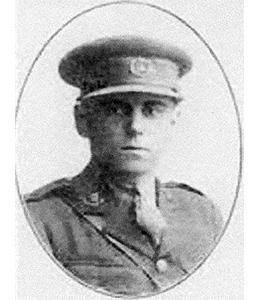Killed in action aged 31
Buried in the Tincourt New British Cemetery Plot X. B. 2
Leonard was born at Bix, Oxfordshire, the second youngest of the eight children of the Reverend the Hon. Algernon Parker, Rector of Bix, a son of the 6th Earl of Macclesfield, and Emma Jane (nee) Kenyon.
Leonard was educated at Marlborough, coming up to Christ Church in 1905. He appears to have been at the College for only one year and it is not known what he did until he received his Flying Certificate on 28 May 1914. He was flying a Bristol bi-plane at the Bristol School at Brooklands.
On 12 August 1914 he was gazetted as a Second Lieutenant on Probation in the RFC Military Wing.
By 1916, he had reached the rank of Major, and Commanded Fifty Two Squadron which had been the first RFC Squadron to be equipped with the new R.E.8 reconnaissance aircraft [nicknamed ‘Harry Tate’ after a successful music hall comedian of the time]. The unit assembled at Rouen before moving southwards to the Somme Sector, where the Squadron made its home at the large aerodrome situated near Bertangles, a village situated a few miles north of Amiens.
Attached to Tenth Corps of the Fourth Army, the squadron undertook its primary role of Corps reconnaissance, a task which entailed the taking of hundreds of aerial photographs, and sketching maps, often in atrocious weather, of the enemy’s positions in the Corps sector to the east. By December the Squadron had moved eastwards to an airfield near the village of Chipilly. On the 7 January 1917, the Squadron suffered its first casualty to enemy action. A little before midday Parker and his observer, Second Lieutenant Mann, left Chipilly in an R.E.8 on a photographic patrol. They never returned, having been shot down half an hour after taking off, north west of Peronne. Parker was killed in the crash, Mann was taken prisoner, and survived the war.
Much of the acclaim for the successful achievements of the opening phase of the Arras Offensive can be placed on the shoulders of the airmen of the Royal Flying Corps. Flying their flimsy aircraft, often in atrocious weather, they took thousands of aerial photographs and drew an equal number of sketch maps, pinpointing every German gun position and strongpoint, thus placing in the hands of the British High Command a complete overview of the obstacles they were facing, and ensuring that the British artillery could accurately pinpoint every enemy gun position. The Corps flew innumerable reconnaissance flights over the enemy’s positions and provided close cooperation to the troops on the ground by ‘strafing’ and bombing enemy troop concentrations once the assault began.
Probate was granted to his father on 7 May 1917. He left £873-6s-11d.


